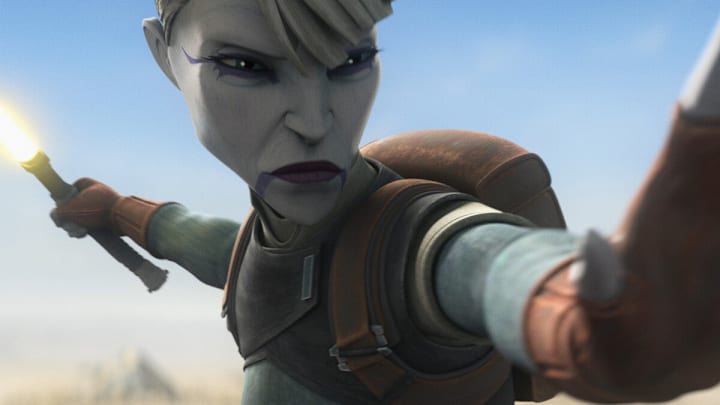This article contains spoilers for Tales of the Underworld, episode 1, "A Way Forward."
When I first started watching the Tales of the Jedi episode, "Resolve," I was overjoyed. Finally, the Ahsoka novel by E.K. Johnston would be brought into canon and adapted for the screen. That excitement quickly turned to confusion and disappointment when I noticed which elements of the story they decided to change.
In Ahsoka, we are introduced to Kaeden Larte. She is a Black, queer woman who becomes Ahsoka's friend and learns to be a hero during the story. As they work together to save Kaeden's home planet from the Empire, she develops a crush on Ahsoka, and their relationship deepens in complexity as they navigate this new dimension. By the end of the novel, Kaeden recognizes that Ahsoka is not able to reciprocate her feelings, and they part ways on positive terms. Kaeden was one of the first queer characters in the new canon, and she meant a lot to fans wanting to see themselves in Star Wars.
Aside from this aspect of the story, "Resolve" is almost the exact same story. The only people missing are Kaeden and her sister. In the show, we see them replaced by two unnamed light-skinned characters. The problem is that Kaeden and her journey were the heart of the novel. Two Black women were erased from the canon. A powerful queer character was excluded from a story that once allowed her to shine.

It was a decision that hurt, and it felt entirely unnecessary. Fans weren't asking for much. If Filoni and his team were already going to adapt this story, why couldn't they have included Kaeden and her sister in the main roles, instead of creating entirely new characters? We have never received a satisfying answer for this.
Now that Tales of the Underworld has been released, we may be seeing a shift in how Filoni tackles stories that have connections to Star Wars novels. In episode 1, "A Way Forward," the first scene shows Jedi Quinlan Vos and Obi-Wan Kenobi transporting the body of Asajj Ventress back to her home to lay her to rest. For anyone who read Dark Disciple by Christie Golden, this scene was both gratifying and shocking because it comes straight from the end of the book.
Dark Disciple follows Ventress and Vos in their efforts to assassinate Count Dooku and save the galaxy from his atrocities. During their mission, the two characters fall in love, and Ventress ultimately sacrifices herself to save Vos from Dooku when their mission goes awry. At the end of the book, Vos takes Ventress back to Dathomir and lays her in a magic pool of water considered very important to her people.
"A Way Forward" picks up where the book leaves off, showing fans how she survived with the help of magic. Unlike in Tales of the Jedi, this scene pays tribute to the book that preceded it. Quinlan Vos is still a part of Ventress's story. He may not have much screen time, but their relationship is still highlighted and respected.

Some may argue that the comparison between these two books is unfair. However, Tales of the Underworld did not have to show how Ventress survived. They could have left it a mystery. Nothing required them to include this scene in the show, but they chose to do so anyway. They created space for a Quinlan Vos, who has received very little screen time so far. They left room for a relationship that has been celebrated by fans of the book.
After the backlash from Tales of the Jedi, we may be on the right path moving forward. Hopefully, the next time Filoni adapts elements of stories in the Star Wars books, he will continue to honor the work of other creators and pay tribute to the stories as they appear on the page.
